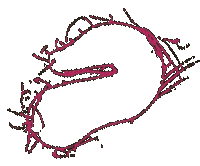March 16, 2004
control etc.
I interviewed at The School of the Art Institute of Chicago on March 6th. One of the things that the interviewers asked of me was "What role does control play in your work?" Somehow, this seemed like the biggest question that I got. I didn't have an answer. I think back about what people have thought about my work and I see the issue of control being brought up again and again. I've never formally addressed it though. I want to now.
It's hard to start off. When I first approached this question, most of the answers I could see coming were all psychoanalytical of myself. I felt uncomfortable with this. I like to put some of myself in my work but I see no need or requirement to go that deep with these particular topics. If I'm a control freak and don't know it, I don't want people to feel they figured that out from just viewing my work. In my work, I use control to provide a narrow focus on a particular movement. I find that when taken in the context of the materials I use, these movements provide for good examples of the types of movements I want people to notice more in their everyday lives. I have, in the past, taken commonly available materials and used them to set up these controlled situations. I use these because they are common and therefor more approachable for my participants. They hint at the possibility that this situation is not isolated to the gallery setting. Recently, I've taken that a step further and started using common objects, modified only to a small degree or not at all, to further the implications for beyond the initial interaction. That's the case with my fork piece; Meditation on Movement: Compressed, Release.
Small example situations can represent what might be found in the uncontrolled environment. My situations do not need to represent specific things you will come across in your daily life. They represent a genre of little movements that I want people to notice and appreciate more. I do cull them from genuine, non-manufactured experiences that I have had and noticed. I morph an inspiration movement into something that is surrounded by devices that help get it across better. Sometimes it seems like these other things get in the way and detract from the experience.
So I put these things out. I make them approachable. I try to I provide things that will lead you to the experience. That's about it. Many of my works have endings but no conclusions, so far. I don't know how I feel about that. One thing I haven't done yet is figure out how to tie up the loose ends of what people are supposed to get out of one of my works. If I don't specifically tell them what to think, what can I do? Do I set up some sort of reward that's linked to them noticing something specific? I don't even know how to do that. I need some non-direct statement of my thesis. That would make a clear differentiation between it being an activity and it being art.
I think I want to create more built in periods of participant self-reflection into the scenario of a piece. I want to cut out the hype and see what happens. These reasons make up the basis for what I'm doing with the performance piece. I hope I can manage to make myself do it. In this piece, it might be that I'm trading in visual cues and other devices for more participation from me. It feels like refinement. I won't know for sure till I start hearing second hand reactions.
I don't know if I need to be more specific in my works. I just want to give an experience that adds to their personal vocabulary of movement. I'm not looking for large changes. In the best case scenario I give them a spark that helps them to notice things better. Maybe they notice it, maybe they don't. I at least want them to think about this individual experience that I have just given them. I just want them to have an opportunity to analyze it. They might only figure what I am trying to accomplish (the participant in more personal situations being able notice and analyze movement better) over the scale of several pieces. That's ok with me.


